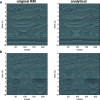Geometry unites synchrony, chimeras, and waves in nonlinear oscillator networks
- PMID: 35364855
- PMCID: PMC8947818
- DOI: 10.1063/5.0078791
Geometry unites synchrony, chimeras, and waves in nonlinear oscillator networks
Abstract
One of the simplest mathematical models in the study of nonlinear systems is the Kuramoto model, which describes synchronization in systems from swarms of insects to superconductors. We have recently found a connection between the original, real-valued nonlinear Kuramoto model and a corresponding complex-valued system that permits describing the system in terms of a linear operator and iterative update rule. We now use this description to investigate three major synchronization phenomena in Kuramoto networks (phase synchronization, chimera states, and traveling waves), not only in terms of steady state solutions but also in terms of transient dynamics and individual simulations. These results provide new mathematical insight into how sophisticated behaviors arise from connection patterns in nonlinear networked systems.
Figures





References
MeSH terms
Grants and funding
LinkOut - more resources
Full Text Sources

